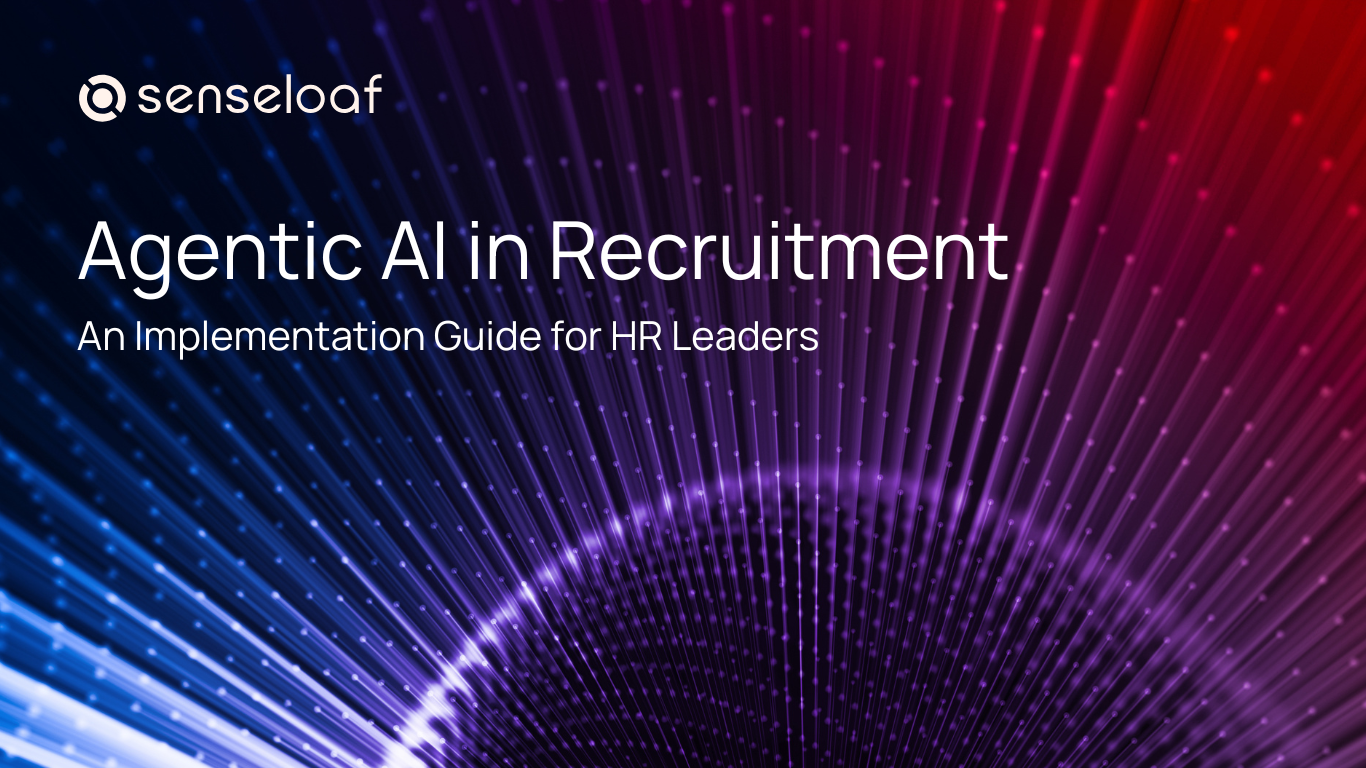The recruitment landscape is undergoing a seismic shift. While nearly 80% of companies report using generative AI, many have yet to see significant bottom-line impact—indicating that agentic AI recruitment is still emerging as the next frontier for practical enterprise value. By 2028, an estimated 33% of enterprise applications will incorporate agentic AI, a sharp increase from less than 1% in 2024, positioning forward-thinking HR leaders at the center of this transformation.
For HR leaders managing high-volume, multi-location, or global recruitment, agentic AI offers an unprecedented edge. Unlike traditional AI that simply automates tasks, agentic AI in recruitment creates intelligent workflows that act, adapt, and optimize—all at scale. By 2027, half of businesses using generative AI are expected to be running agentic AI pilot programs, making now the critical time to understand and implement these systems.
This comprehensive guide explores agentic AI how it works, why it's critical for large enterprises, and provides a step-by-step implementation roadmap tailored for high-volume hiring teams ready to transform their recruitment operations.
Understanding Agentic AI Recruitment
Agentic AI centers around autonomous AI systems that can perceive their environment, make decisions, pursue goals, and collaborate across functions with minimal human intervention, allowing recruitment teams to focus on strategic initiatives. A Prosper Insights & Analytics survey found over 20% of employees, 30% of business owners, and 40% of executives are aware of agentic AI, highlighting growing recognition in enterprises.
In recruitment context, agentic AI in recruitment deploys multiple specialized agents—resume screening bots, candidate engagement assistants, interview evaluators, and feedback analyzers—that interact with both data and each other to achieve end-to-end hiring outcomes.
Core Capabilities in Large-Scale Recruitment
Autonomous Screening Excellence: Agents parse and match resumes to job descriptions with exceptional accuracy, using natural language processing to significantly reduce manual screening time while analyzing resumes, job applications, and cover letters to match candidates with suitable roles.
Multi-Agent Orchestration: Each AI agent (parsing, scoring, scheduling, interviewing) works in perfect synchronization to shorten hiring cycles, with seamless integration through connectors that automate data collection from emails, browsers, and bulk files.
Dynamic Candidate Interactions: Unlike scripted chatbots, agentic AI supports dynamic interviewing by adapting questions based on candidate responses, enabling more nuanced candidate evaluation while handling real-time queries, follow-ups, and interview preparation guidance.
Continuous Intelligence: Through reinforcement learning, the system becomes progressively smarter with every cycle, learning from hiring outcomes, recruiter actions, and candidate feedback to improve performance continuously.
Why Agentic AI Is Purpose-Built for High-Volume Recruitment
Large enterprises consistently face recruitment challenges that traditional methods struggle to address:
- Volume Overwhelm: Processing 100K+ applications across roles, regions, and verticals
- Repetitive Hiring Cycles: Constant recruitment for frontline, sales, retail, and operations positions
- Timeline Compression: Extended screening and shortlisting periods that delay critical hires
- Experience Deterioration: High candidate drop-offs due to poor engagement and communication
Agentic AI recruitment directly addresses these enterprise pain points through:
Unprecedented Speed: Resume parsing and job description matching completed in seconds, not hours or days
Precision-Driven Accuracy: Goal-oriented matching based on comprehensive skills analysis, moving beyond simple keyword matching
Limitless Scalability: No operational ceiling on role count, geographic locations, or candidate volume
Enhanced Candidate Experience: 24/7 conversational AI providing personalized engagement and tailored job suggestions with real-time feedback
Seamless Integration: Native compatibility with existing ATS, CRMs, and video interviewing platforms
Measurable Impact: What the Data Shows
The transformative potential of agentic AI in recruitment is supported by compelling metrics:
- Automation Efficiency: Agentic AI autonomously handles essential recruiting tasks and automates about 80% of recruiters' repetitive workload, freeing human recruiters to focus on complex decision-making and final candidate selection
- Productivity Gains: Enterprises report potential productivity gains of 20-60% in workflows assisted by AI agents, directly applicable to recruitment processes
- Operational Excellence: Significant cost savings through reduced time-to-fill positions and improved hiring accuracy, allowing companies to attract and retain top talent more efficiently
- Quality Enhancement: Bias-free hiring through masking personal identifiers (gender, ethnicity, age) to ensure decisions based solely on qualifications and experience, while using predictive analytics to forecast candidate success and retention likelihood
Enterprise Implementation Roadmap: Your 6-Phase Blueprint
Phase 1: Strategic Foundation and Alignment
Objective: Establish clear transformation vision and stakeholder buy-in
Key Activities:
- Conduct comprehensive challenge assessment: slow screening, high attrition, or poor candidate experience
- Define measurable business KPIs: time-to-fill, offer-accept ratio, recruiter efficiency metrics
- Map complete stakeholder ecosystem: talent acquisition leads, IT leadership, compliance teams, finance
- Perform competitive landscape analysis: peer AI adoption and outcomes
Success Example: A major retail organization recruiting 25,000 seasonal workers in 6 weeks identified reduced time-to-hire and decreased candidate drop-offs as primary transformation goals.
Phase 2: Technical Infrastructure and Data Readiness
Objective: Prepare foundational systems for agentic AI integration
Critical Assessments:
- Audit existing ATS/HRMS systems for API compatibility and integration capabilities
- Standardize resume formats and create comprehensive job description repositories
- Ensure robust data privacy and regulatory compliance (GDPR, SOC2, industry-specific requirements)
- Evaluate current candidate datasets for quality, structure, and appropriate labeling
Professional Insight: Multimodal agents achieve optimal performance with structured behavioral and communication data inputs, requiring comprehensive data preparation.
Phase 3: Strategic Use Case Selection and Agent Architecture
Objective: Prioritize high-impact, scalable workflows for initial deployment
High-Value Use Cases:
- Intelligent Resume Parsing + Advanced Skill Matching
- Dynamic Screening Bots with Adaptive Knockout Questions
- Automated Interview Scheduling with Conflict Resolution
- AI-Powered Video Interview Agents with Behavioral Assessment
- 24/7 Candidate FAQ Management + Real-Time Status Updates
Agent Specialization Framework:
- Agent A: Match candidate resumes to job descriptions with precision scoring
- Agent B: Evaluate candidates across domain expertise and soft skills
- Agent C: Manage candidate engagement via WhatsApp, email, and SMS
- Agent D: Generate comprehensive recommendation summaries for human recruiters
Industry Benchmark: Leading consumer goods companies have achieved $1M+ savings and 75% hiring time reduction through strategic AI interview agent deployment.
Phase 4: Controlled Pilot Implementation (Copilot Mode)
Objective: Establish human-AI collaboration with comprehensive feedback loops
Pilot Strategy:
- Begin with 1-2 specific functions (sales, customer support, operations)
- Implement AI recommendation system with human decision authority
- Establish rigorous measurement protocols: precision scores, processing speed, recruiter satisfaction
- Create continuous improvement cycles based on recruiter feedback and system performance
Success Metrics: Target match accuracy >85%, positive recruiter NPS scores, reduced time-to-first-touch, decreased candidate drop-off rates.
Phase 5: Full-Scale Autonomous Deployment (Autopilot Mode)
Objective: Transition from assistive to autonomous hiring operations
Scaling Activities:
- Expand successful pilots to additional departments and geographic regions
- Deploy comprehensive end-to-end AI orchestration for high-volume, repeatable roles
- Enable AI-led candidate management from application through assessment
- Route only final candidate shortlists to human recruiters for decision-making
Enterprise Example: Global logistics companies successfully use agentic AI recruitment to hire 15,000+ delivery associates quarterly across 10+ countries with minimal human intervention.
Phase 6: Governance, Ethics, and Continuous Optimization
Objective: Ensure sustainable performance, fairness, and continuous improvement
Governance Framework:
- Bias Prevention: Regular auditing of shortlists across gender, regional, and age demographics
- Privacy Protection: Comprehensive candidate consent management for AI-based screening processes
- Learning Systems: Continuous AI enhancement through historical hire analysis, recruiter overrides, and post-hire success tracking
- Performance Monitoring: Quarterly KPI reviews covering performance metrics, quality-of-hire, AI precision, and candidate feedback
Critical Implementation Pitfalls to Avoid
❌ Deployment Without Change Management: Rushing AI implementation without comprehensive organizational preparation and training
❌ Generic Tool Selection: Using off-the-shelf solutions not customized to your specific hiring data and requirements
❌ Ignoring Human Feedback: Failing to incorporate recruiter insights into agent learning and optimization cycles
❌ Automation-Only Focus: Prioritizing efficiency over candidate experience and engagement quality
The Strategic Imperative: Why Now?
Agentic AI recruitment has evolved beyond experimental technology—it's becoming the essential backbone for scale, speed, and precision in enterprise hiring. For HR leaders, the transition from traditional tools to intelligent systems represents not just strategic advantage, but operational necessity.
The compelling business case for immediate action:
- 50% Reduction in Time-to-Hire: Dramatically accelerate recruitment cycles
- Personalization at Enterprise Scale: Deliver individualized candidate experiences across thousands of interactions
- 80% Decrease in Manual Screening: Free recruiters for strategic, high-value activities
- Enhanced Hiring Quality: Improve consistency and accuracy across all locations and roles
Your Next Steps: From Strategy to Implementation
The transformation opportunity is clear. By 2027, half of businesses using generative AI will be running agentic AI pilot programs. The question isn't whether to implement agentic AI in recruitment—it's how quickly you can establish competitive advantage through intelligent hiring systems.
With 33% of enterprise applications set to incorporate agentic AI by 2028, the time to act is now. Consider SenseLoaf for agentic AI hiring - the enterprise-ready solution that's already helping global companies hire smarter, faster, and fairer.
Don't wait for your competition to gain the advantage. Start your agentic AI recruitment transformation with SenseLoaf AI today.







